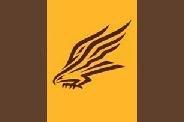Bola Mine
| Bola Mine | ||||||||
|---|---|---|---|---|---|---|---|---|
|
Contents
Flag

Sacred Tree
Situated 6 kilometres east of Bola Mine is its Sacred Tree EREGRI. In spite of, or perhaps because of, the degradation of the city environs the Bolas care very deeply for the tree.
Location
Bola Mine is situated on the eastern slopes of the steep northern Goolengook River Valley. With the huge mass of Mount Ellery looming on the western side of the river it has one of the most spectacular views in Errinundera. The town itself is quite ugly, with the justified reputation of having the most degraded environment in the nation. The forest surrounding the town and mines is, however, in wilderness condition.
Gold Mining and Rebellion
The reason for the existence of Bola Mine is its namesake gold mine. The income from the mine provides a huge fillip to the nation's GDP and to the government's tax revenues. For much of the mine's life arsenic from the mining process and tree-felling to provide fuel and building materials resulted in severe degradation of the river and forest.
In the nineteenth century the town was famous for its lawlessness. In 1854 the owner of the Bola Mine Hotel was charged with murdering a miner. The accused was a member of the Milosis royal family and, in what was seen by miners as a partisan decision, was acquitted by the royally appointed court. The miners reacted by burning down the hotel. This is regarded by some scholars as the first instance in the nation of Corporate Torching although most believe that, because the miners were severely dealt with subsequently and because there was no corporate laws in existence at the time, this was not a genuine instance of the modern practice. Furthermore, it is argued that the reprisals were against the misbehaviour of an individual, not the malpractices of a business - the hotel being otherwise popular with miners.
In the aftermath of the hotel fire there were pitched battles between soldiers and miners resulting in the deaths of 31 of the latter. A further 23 were arrested and executed. Historians believe that the events contributed to the widespread dislike of military and police forces among Errinundrians.
Shortly after the 1941 Liberation revolutionaries from Goolengook, led by the legendary amamotoy, stormed the mine and closed it down. It remained closed for several decades afterwards. A year later the Goolengook Dam, situated a short distance downstream from the town, was dynamited by the same group. Unfortunately, floodwaters from the action washed away portions of the city of Goolengook. The ruins of the dam are now a national monument.
Restoration
In the 1980s many were keen to re-open the mine. After much public debate it was decided to re-commence mining under very strict environmental conditions. The ownership of the mine is split equally 4 ways, the owners being: the town of Bola Mine; the city of Goolengook on behalf of the Goolengook region; the nation of Errinundera on behalf of all other regions and cities; and a trust set up to finance the environmental rehabilitation of the river and the forest.
The rehabilitation has proved to be popular and successful and the town has been booming with the income generated from the mine.
The New Bola Mine Hotel
The Bola Mine Hotel was re-opened in 1942 and remains the only hotel in the town. It is owned by the township and all profits from the hotel are given to the Bola Mine Arts Foundation. Patrons of the hotel have the consolation, as they get themselves ripped, that it is all in a good cause.
News Media
Bola Mine is very proud of its primary News Media publication, The Bola Mine Times. It was opened just in time to cover the burning of the Bola Mine Hotel and the subsequent troubles. Throughout the events the proprietor, seecamph, staunchly supported the miners and was subsequently jailed for sedition.

Trivia
The nation's currency is named after the mine.
